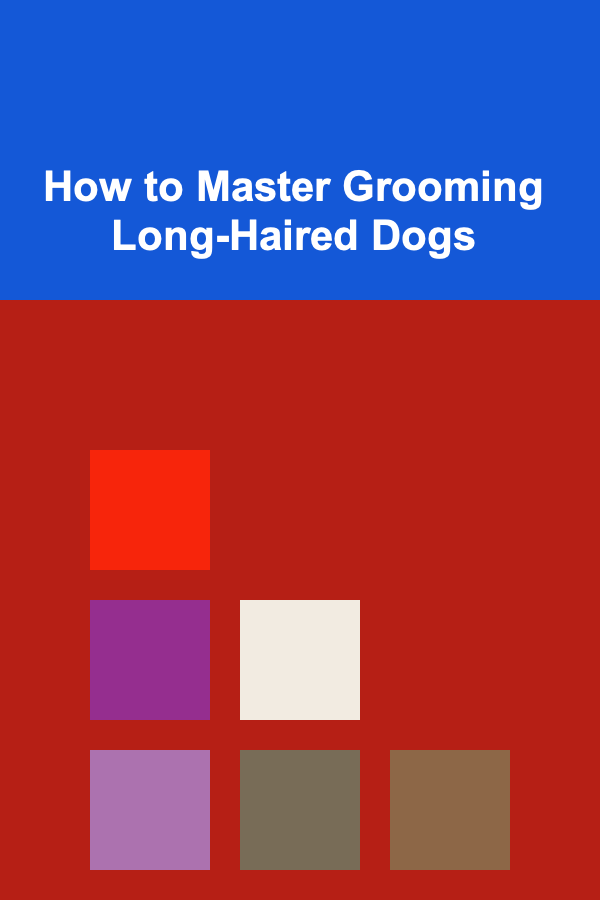
How to Master Grooming Long-Haired Dogs
ebook include PDF & Audio bundle (Micro Guide)
$12.99$6.99
Limited Time Offer! Order within the next:

Grooming long-haired dogs is an essential part of their care routine, but it can also be an overwhelming task if you don't know the proper techniques. Long-haired breeds, with their luxurious coats, require regular grooming to maintain their health, comfort, and appearance. If not groomed properly, their hair can become tangled, matted, and prone to skin issues. The grooming process is not just about brushing; it involves a variety of tasks, including bathing, trimming, and regular maintenance to keep your dog looking and feeling great.
In this comprehensive guide, we'll explore the steps to master grooming long-haired dogs, the tools you'll need, common challenges, and how to address specific grooming needs for various long-haired breeds.
Understanding the Need for Grooming
Long-haired dogs have coats that require more attention compared to their short-haired counterparts. Their longer fur has a tendency to mat, tangle, and accumulate dirt and debris more easily. Regular grooming helps prevent these issues, ensuring that the dog remains comfortable and that their coat stays shiny and healthy.
Why Grooming Is Important
- Prevents Mats and Tangles: Long hair is prone to tangling, which can lead to painful mats. Regular brushing and combing prevent these issues.
- Skin Health: A well-groomed coat allows air to reach the skin, preventing the growth of bacteria and fungi, which can lead to infections or hot spots.
- Improves Comfort: Tangled and matted hair can pull on the dog's skin, causing discomfort. Grooming ensures that the dog's coat remains smooth and free from painful knots.
- Shiny, Healthy Coat: Regular grooming promotes the distribution of natural oils in the dog's fur, contributing to a healthy, shiny coat.
- Bonding Time: Grooming your dog also strengthens the bond between you and your pet. It's an opportunity to show your dog affection and spend quality time together.
The Essentials of Long-Haired Dog Grooming
Before diving into the detailed grooming steps, it's crucial to gather the proper tools. Having the right equipment not only makes the grooming process easier but also ensures your dog's safety and comfort. Here are the essentials you'll need:
Essential Grooming Tools
-
Brushes: There are different types of brushes for different purposes:
- Slicker Brush: Best for detangling and removing mats.
- Pin Brush: Useful for overall coat brushing and maintaining smoothness.
- Bristle Brush: Ideal for finishing touches and distributing oils throughout the coat.
- Rake Comb: A great tool for removing dead hair and preventing matting, particularly in dense or thick coats.
-
Combs: A wide-tooth comb works well for detangling, while a fine-tooth comb is ideal for finer hair or more delicate areas, like the ears and face.
-
Clippers or Scissors: If your dog's coat requires trimming, having a good pair of clippers or scissors is essential. Clippers are great for a quick, clean trim, while scissors are useful for more detailed work.
-
Nail Clippers: Keeping your dog's nails trimmed is just as important as grooming their coat. Long nails can cause discomfort and health problems.
-
Shampoo and Conditioner: Choose a dog-specific shampoo that is gentle on their skin. Long-haired dogs, especially those with sensitive skin, benefit from moisturizing and nourishing conditioners.
-
Ear Cleaner: Long-haired dogs are prone to ear infections, so cleaning their ears is an important part of grooming.
Setting Up the Grooming Area
Creating a calm, comfortable environment for grooming is essential. Ensure that you have a well-lit area with enough space for your dog to move around. If your dog is large or anxious, it may help to have a grooming table or a mat on the floor to prevent them from squirming too much.
Grooming Steps for Long-Haired Dogs
Now that you have the tools, let's go over the actual steps involved in grooming your long-haired dog. These steps can be adapted depending on the breed and the specific needs of your dog, but the general principles remain the same.
Step 1: Prepare Your Dog for Grooming
Before you begin, it's essential to make your dog feel comfortable. Start by getting them used to the grooming tools. Allow them to sniff and explore the brushes and combs. Gently pet your dog to relax them, and ensure they are calm before beginning.
If your dog is nervous or anxious about grooming, it may help to do short sessions, gradually building up their tolerance over time. Praise and reward your dog throughout the process, creating a positive association with grooming.
Step 2: Brushing the Coat
Brushing is the foundation of any grooming routine. It helps to remove tangles, mats, and dead hair, keeping the coat healthy. Long-haired dogs should be brushed regularly, at least two to three times a week, depending on the breed.
How to Brush a Long-Haired Dog
- Start from the Top: Begin brushing at the dog's neck or back, working your way down toward the tail.
- Use a Slicker Brush: Start with a slicker brush to detangle the coat. Gently work through any tangles, starting at the ends of the hair and working your way up to the roots. This prevents pulling and discomfort for the dog.
- Brush in Layers: Long-haired coats can become matted if the hair is brushed all in one go. Instead, work in small sections, brushing each layer thoroughly. Be patient and gentle, as some tangles may take time to loosen.
- Check for Mats: Pay special attention to areas where mats tend to form, such as behind the ears, under the armpits, and around the legs. If you encounter a mat, use your fingers or a mat splitter tool to gently loosen it before continuing.
- Finish with a Pin Brush: After removing any tangles and mats, finish the brushing with a pin brush. This helps smooth out the coat and distribute natural oils, leaving the coat shiny and soft.
Step 3: Bathing Your Dog
Bathing long-haired dogs is important to keep their coats clean and healthy. Regular bathing prevents dirt buildup and can help manage shedding. However, it's important not to bathe your dog too frequently, as this can strip their coat of natural oils. Bathing every 4 to 6 weeks is usually sufficient for most long-haired breeds.
How to Bathe a Long-Haired Dog
- Use Lukewarm Water: Always bathe your dog with lukewarm water, as hot water can irritate their skin and coat.
- Wet the Coat Thoroughly: Wet your dog's coat gradually, ensuring it's completely soaked before applying shampoo.
- Apply Shampoo: Use a dog-specific shampoo and lather it gently into the coat. Avoid getting shampoo in your dog's eyes or ears.
- Rinse Thoroughly: Ensure all shampoo is thoroughly rinsed out to prevent irritation or buildup.
- Condition the Coat: Apply a conditioner to the coat, focusing on the ends to help prevent tangling and dryness. Rinse it out thoroughly.
- Drying: After the bath, gently towel-dry your dog to remove excess moisture. If your dog is comfortable with it, use a blow dryer on the lowest heat setting to dry their coat. Keep the dryer at least a few inches away from their skin to prevent burns. Make sure the coat is completely dry before brushing again.
Step 4: Trimming and Cutting the Coat
Some long-haired breeds may require occasional trimming to keep their coats manageable. Trimming helps to maintain a neat appearance and can prevent the coat from becoming too thick or unruly.
How to Trim a Long-Haired Dog's Coat
- Use Proper Scissors or Clippers: For a clean trim, use a good pair of grooming scissors or clippers. Clippers are faster and more effective for large areas, while scissors are better for fine details.
- Trim in Small Sections: Work in small sections, trimming a little at a time to avoid cutting too much.
- Be Cautious Around Sensitive Areas: Take extra care when trimming around sensitive areas like the face, paws, and ears. Use blunt-end scissors when trimming around the eyes to avoid injury.
- Trim the Tail: The tail is often a focal point, so ensure it is well-groomed. Trim any excess hair from the tail to keep it looking neat.
- Ears and Paws: Long-haired dogs are prone to hair growth around the ears and paws. Trim this hair regularly to prevent mats and to keep the dog comfortable.
Step 5: Nail Clipping
Nail clipping is an essential part of grooming for all dogs, and long-haired dogs are no exception. Overgrown nails can cause pain and lead to joint problems over time. Regular nail trimming ensures that your dog is comfortable and prevents damage to furniture and floors.
How to Clip Long-Haired Dog's Nails
- Use Nail Clippers: Use a pair of dog-specific nail clippers to trim the nails. If your dog's nails are dark, it may be difficult to see the quick (the sensitive part of the nail), so be careful not to cut too close.
- Trim Little by Little: Trim small portions of the nail at a time to avoid cutting too much.
- File the Nails: After clipping, use a nail file to smooth out any rough edges.
Step 6: Ear Cleaning
Long-haired dogs are prone to ear infections, especially in breeds with floppy ears. Regular ear cleaning helps prevent infections and keeps the ears smelling fresh.
How to Clean a Long-Haired Dog's Ears
- Use Ear Cleaner: Use a dog-specific ear cleaner. Apply a few drops to the ear canal and gently massage the base of the ear.
- Wipe the Ear: Use a cotton ball or soft cloth to gently wipe the ear, removing dirt, wax, and debris.
- Avoid Inserting Anything Into the Ear Canal: Never insert anything into the dog's ear canal, as this can cause injury.
Conclusion
Mastering the art of grooming long-haired dogs requires patience, consistency, and the right tools. By following the steps outlined in this guide and making grooming a regular part of your dog's care routine, you can ensure that your long-haired companion remains healthy, comfortable, and looking their best. Remember, grooming is not just about the aesthetics; it's about the overall well-being of your dog, both physically and emotionally. With time and practice, grooming will become an enjoyable bonding experience for you and your dog.

Create Passive Income Streams with Deep Learning and Machine Learning
Read More
How to Host a DIY Crafting Party for Friends and Family
Read More
How to Reduce Food Waste with Smart Meal Prep
Read More
How to Set Up a Space-Saving Laundry Room in Your Home
Read More
How to Use Labels Effectively for Meal Prep Containers
Read More
10 Tips for Automating Your Performance Management Planner
Read MoreOther Products

Create Passive Income Streams with Deep Learning and Machine Learning
Read More
How to Host a DIY Crafting Party for Friends and Family
Read More
How to Reduce Food Waste with Smart Meal Prep
Read More
How to Set Up a Space-Saving Laundry Room in Your Home
Read More
How to Use Labels Effectively for Meal Prep Containers
Read More